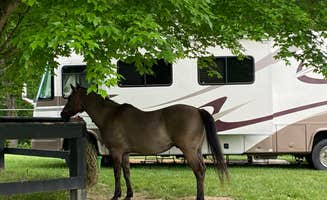Hoosier National Forest offers 202,814 acres of diverse terrain with over 266 miles of recreational trails. Located in south-central Indiana, the forest spans nine counties with elevations ranging from 361 to 1,033 feet above sea level. Camping areas tend to be busiest in spring and fall when temperatures average between 50-75°F, with summer visitation dropping due to higher humidity levels.
What to do
Cave exploration: 5 miles from Spring Mill State Park. The park features several caves, including boat-guided tours through underground waterways. "Some caves are guided by boat. Very neat to see. Also has a pioneer village for touring along with a visitor center honoring astronaut Virgil Gus Grissom," reports Donald T. from Spring Mill State Park Campground.
Hiking trails: Access from multiple points. The Charles C. Deam Wilderness area offers challenging terrain with significant elevation changes. "The trails are well paved and marked, not too strenuous. So many beautiful trees and plants to see, plus lots of creeks to walk through," notes Hannah F. who visited during morel mushroom season in mid-April.
Fishing spots: Throughout forest boundaries. Blackwell Campground provides access to fishing areas with varying catch rates depending on season. "A quiet, peaceful spot in the forest. A few horses on the trail on weekends. French Lick is 30 minutes away," shares Mark D. about the location's convenient access to both nature and nearby attractions.
What campers like
Quiet atmosphere: Minimal light pollution. Berry Ridge Road dispersed camping offers secluded sites away from crowds. "Multiple campsites in the area, I've stayed at two both of which were away from others, clean, fairly flat and had plenty of dead wood around to burn. Some sites, at least one, could fit a pretty good sized camper," explains Jeremy F..
Wildlife viewing: Early morning opportunities. Campers frequently spot deer, wild turkeys, and various bird species. "The chorus frog do roar through the night. 100% worth it, make sure to bring bug spray, and travel carefully up the roads. Lots of wildlife, and kind people," says Elizabeth W. who visited Youngs Creek Horse Camp.
Geological features: Throughout forest trails. The area contains interesting rock formations and natural features. "I walked the creek for hours just looking at all the rocks on the sandbars. I have never encountered so many geodes in my life. Truly magnificent to encounter," reports Sarah R. about her experience at Charles C. Deam Wilderness.
What you should know
Weather considerations: Spring brings rain. Trails can become muddy and difficult to navigate after rainfall. "The only negative was that we came after a lot of rain. So everything is permanently wet and mosquitos/ticks abounded," notes a Charles C. Deam Wilderness visitor.
Limited amenities: Most sites primitive. Many camping areas lack modern facilities. "The site has a toilet and water. If you head into the town of Paoli be sure to hit up the farmers co-op for supplies," advises David M. at Youngs Creek Horse Camp.
Road conditions: Challenging for some vehicles. Forest roads vary in quality and maintenance status. "Secluded site that is pretty far off of the road, but not too far. I have a promaster conversion and had no trouble making it to this site, however the road was gravel and steep at times," reports Amber R. about Berry Ridge Road.
Tips for camping with families
Beginner kayaking: No-wake zones available. Deam Lake offers calm waters ideal for inexperienced paddlers. "Perfect lake to kayak for a beginner bc no wake zone also the cabins are cool and cozy just bring a mattress the restrooms are definitely the cleanest and well taken care of anywhere I've ever been," recommends Brandy A..
Educational programs: Ranger-led activities. Several campgrounds offer scheduled nature programs. "They had a Smokey the Bear program for the kids and some really fun activities at the nature center while we were there. We were able to rent a paddle boat for $8/hr and saw tons of turtles," shares Jessie W. about Spring Mill State Park.
Kid-friendly trails: Under 2 miles. Look for shorter loop trails with interesting features. "We enjoyed the sycamore loop, which was around 6 miles. Everyone is super kind in the area, except for the gravel road to park (which is limited)," adds Hannah F. about Charles C. Deam Wilderness.
Tips for RVers
Site selection: Check leveling requirements. Many forest campsites have uneven terrain. "We spent a week at spring mill state park. The site we where at was heavily sloped, the only flat part was where they put the fire pit at. When we looked at the other site most of the shaded sites that had some privacy where also heavily sloped," warns Thomas U. about Spring Mill State Park.
Parking limitations: Narrow access roads. Some campgrounds have restricted turning radius for larger vehicles. "Great boondocking spot, plenty of flat land making leveling easy. Wide open so solar charging was easy. We were there for 7 days and while they have room for probably 50 or 60 rigs there was only 3 or 4 of us there most of the time," explains The Wandering Shores about Blackwell Campground.
Water access: Plan ahead. Most dispersed sites lack hookups. "The campground is located inside the state park entrance so the gate fee applies to your first entry, but once you check into your site you can come and go as you wish. There is a little camp store with decent prices," notes Laura O. about Spring Mill State Park.



